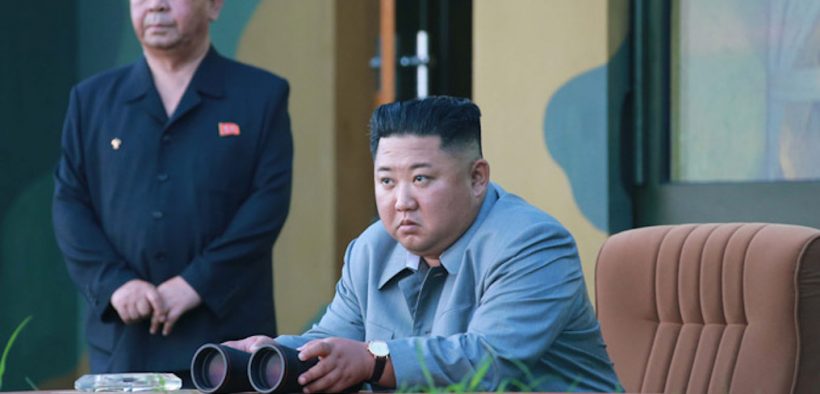North Korea Launches Missiles Despite US Optimism Over Denuclearization Talks

“This is the big problem with having a showman, reality TV star running the American side because he doesn’t actually know anything about what’s negotiated.”
Last Thursday, North Korea tested a new type of short-range ballistic missile under the direct supervision of North Korean leader Kim Jong-Un. The missile test, North Korea’s state press claimed, was in response to the continuation of joint military training exercises between neighboring South Korea and the U.S. scheduled for August.
Pyongyang’s latest missile test also comes less than four weeks after Kim’s abrupt meeting at the Korean Demilitarized Zone (DMZ) with President Donald Trump at the end of June.
North Korea’s most recent previous test was in May and included the testing of a short-range missile and small rocket. Two days before the Thursday test, the 36-year-old leader inspected a newly-built submarine, stating the submarine “will perform its duty in the operational waters of the East Sea of Korea and its operational deployment is near at hand.”
The inspection hinted that Pyongyang would continue its nuclear program. Analysts speaking to the Guardian claimed that the new vessel was clearly capable of delivering ballistic missiles.
“We can clearly see that it is a massive submarine – much larger than the existing one that’s been well known since 2014,” said Ankit Panda, a senior fellow at the U.S.-based Federation of American Scientists, to the Guardian.
“What I find significant about the political messaging here is that this is the first time since a February 2018 military parade that he has inspected a military system clearly designed to carry and deliver nuclear weapons,” Panda added.
According to North Korea’s Central News Agency (K.C.N.A.), North Korea’s missile test was prompted by the continuation of military exercises off the South Korean peninsula by the U.S. and South Korean military which North Korea called “strange double-dealing behavior.”
A K.C.N.A. report released after the North Korean missile test, described South Korea as clearly developing offensive weapons which posed a direct threat to North Korea.
“He (Kim) said that the ultra-modern weapons and equipment which the bellicose forces of the South Korean military are introducing with desperate efforts are definitely offensive weapons and their purpose is absolutely clear. He stressed it is a work of top priority and a must activity for the security of the country to steadily develop powerful physical means and conduct the tests for their deployment for neutralizing those weapons posing undeniable threats to the security of the country,” said the K.C.N.A. report.
Why Did North Korea Test a Missile Again?
Analysts also see the latest test as an expression of Pyongyang’s grave disappointment over negotiations with the U.S. which have not run smoothly and have made no concrete progress.
Kim Dae-young from The National Security Strategy Institute under South Korea’s National Intelligence Body said that North Korea fired the test missile to try to get what it wants after frustration over stalled diplomatic efforts with Washington.
“North Korea appears to be thinking its diplomacy with the U.S. isn’t proceeding in a way that they want. So they’ve fired missiles to get the table to turn in their favor,” the expert told Politico.
Another analyst echoed Dae-young’s statement, saying that the tests are being used as a tool to pressure the Trump administration.
“The launches build on a series of signals over the past few months that the North, despite its continued interest in talks with the U.S., was taking a harder line on the U.S.” Minyoung Lee, a senior analyst told NKNews.
Despite Missile Tests, US Remains Optimistic
“[T]hey are short-range missiles, and many people have those missiles,” Trump said regarding the recent North Korean missile launch, adding that the launches involved “very standard missiles.”
U.S. Secretary of State Mike Pompeo echoed Trump and issued similarly dismissive comments.
“Everybody tries to get ready for negotiations and create leverage and create risk for the other side,” the former CIA boss stated.
Before the DMZ meet-up, Trump and Kim met in Singapore in June of 2018 and Hanoi in February of 2019. Those talks failed to produce any consensus on denuclearization efforts due to a different understanding of how a denuclearization timeline would proceed, despite Trump’s boastful remarks that he has a “very good relationship” with Kim.
North Korea wants the sanctions to be partially lifted while Washington demands Pyongyang give up its nuclear weapons first. Despite both sides declaring the DMZ talks a success, neither side mentioned any specifics about denuclearization proceedings nor sanctions removal.
While the missile tests themselves do not violate North Korea’s self-declared moratorium on ICBM tests, many experts cast doubt about whether the U.S. can make North Korea dismantle its nuclear arsenal.
“This is the big problem with having a showman, reality TV star running the American side because he doesn’t actually know anything about what’s negotiated,” Robert Kelly, professor of political science and diplomacy at Pusan National University, told TIME Magazine.













